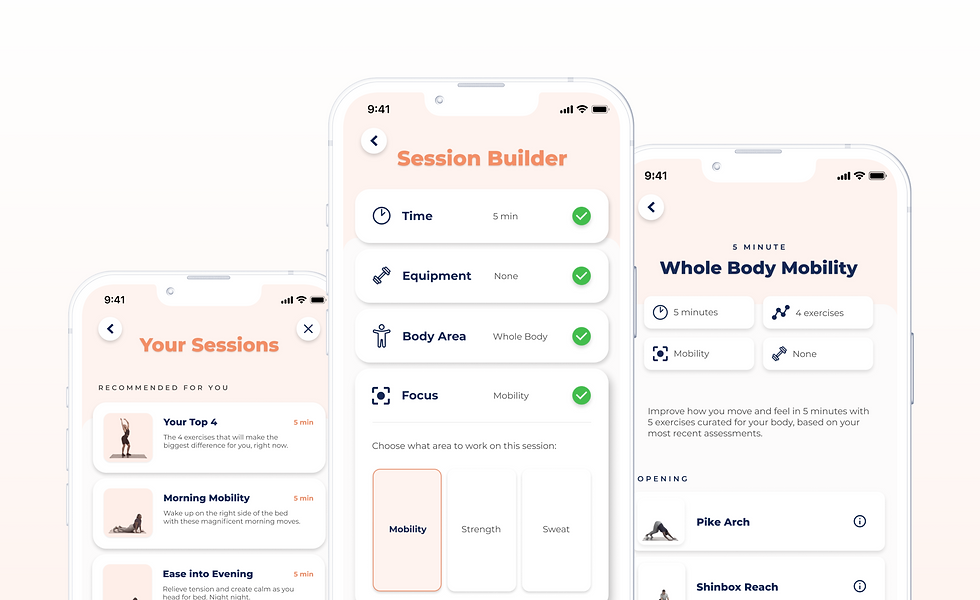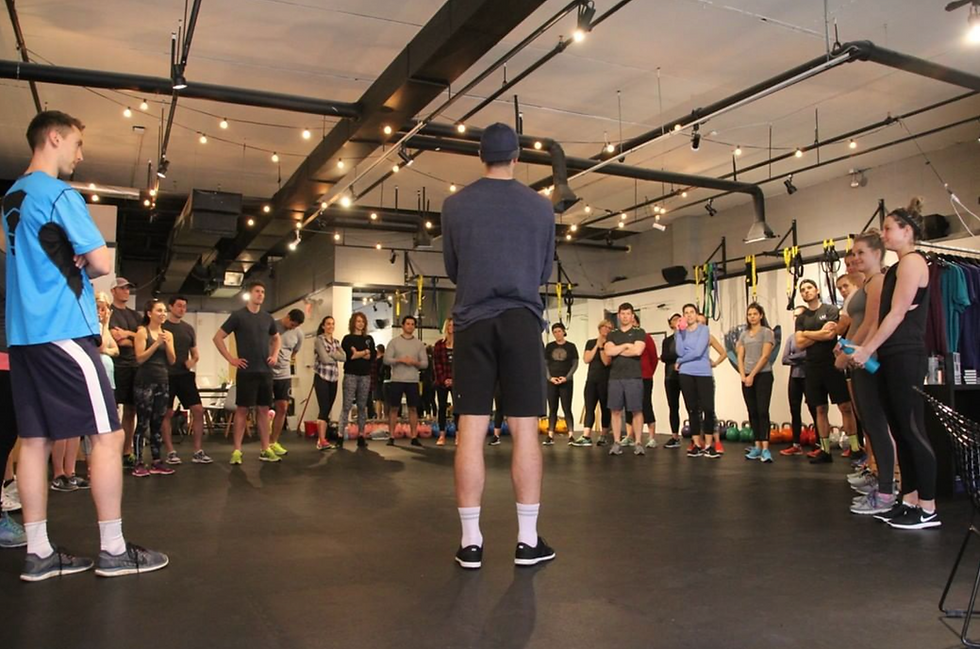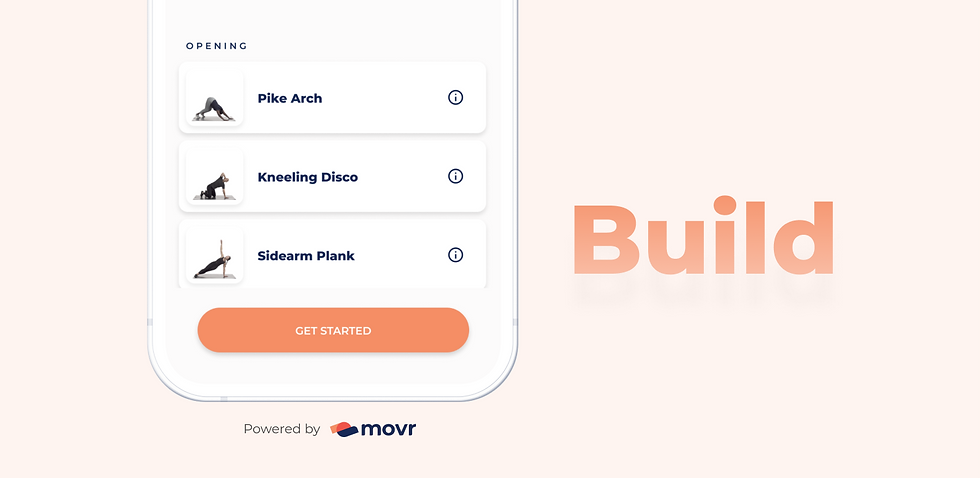The problem with modern exercise programming (and how we're solving it)
- Aaron de Jong
- Mar 2, 2023
- 5 min read
Despite modern technological advances, our general approach to exercise programming is still outdated and dysfunctional. Here's how we're changing that.

Back in 2008, I noticed a strange trend.
During my time at the University of Victoria, I had the privilege of working in both the athletic therapy clinic and the varsity gymnasium. From pretty much the beginning, I noticed something that didn't sit right.
I'd see varsity athletes in the clinic with recurring injuries – things like hamstrings, low back pain, muscle pulls, hip dysfunction or just... pain. These athletes would get treatment, be asked to do a few very foundational exercises for hip, core and balance and then head out the door.
Soon after, I would see those same athletes in the gym doing the same strength program as everyone else on their team – heavy bench, some shoulder pressing, maybe some deep squatting and call it a day. Inevitably I'd see this cycle repeat over and over again. Injured athletes with obvious movement dysfunction would get patched together by very talented athletic therapists, only to hit the gym with a generic program and put load on top of dysfunction.
While the problem here is obvious to me now, back then it was something I was learning about in real-time. It was the first of several "a-ha" moments early on in my career that set me on the path of creating a different way to help people move and perform better.

The problem with modern workout programming.
Since my time at clinic, I had dedicated myself to becoming the best strength and movement coach I could. Between personal and group training, I was learning a ton about movement health and how to improve it with everyone I saw in person.
I focused specifically on assessments as a means to determine what exercises were appropriate for different bodies and abilities.
I absorbed Grey Cook’s Movement, the FMS systems and how the body is connected with different layers of tissues – all with different functional demands, all requiring attention relating to movement limitations.
I owned a boutique studio in Vancouver, BC and was tinkering with a movement protocol for everyone who entered the doors. I wanted each person to be met with a workout that challenged them, but was appropriate for their body.
At the time (and still very much today), exercise delivery was programmatic and template driven. If you wanted a workout, you’d read up how to periodize or what muscle groups to train, and you’d add intensity or volume metrics to inform ratings of perceived exertion or sweat.
Then I read this study. It laid out the startling truth that zero percent of apps at the time were making a measurable impact on mobility.
This was a major flag. All the way back in that clinic, I'd learned that mobility was the foundation of quality movement function and performance. It was a truth I'd seen validated over and over since then with my own clients and through the FMS systems. So how could no digital fitness providers be doing anything about it?
The problem was becoming clearer to me. Despite the many technological advances since my time at clinic in 2008, the approach I'd seen there was still prevalent. We were still approaching movement health in an outdated and dysfunctional fashion.
Something needed to be done.

Looking at the same workout, differently.
The original movr was a functional workout programmer. What it did differently was that instead of looking at muscle groups, we categorized exercises within movement patterns.
A squat is a pattern, and there are various ways to squat under different loads that add complexity to that pattern. Within the various ways to squat, the functional requirements on the body remain the same: your ankles, knees, hips, core and spine need to function together through mobility and stability to perform a healthy squat. The same is true for horizontal or vertical pushing and pulling. The same for hinging, lunging, rotating or doing any dynamic core work on the ground.
So instead of saying “Today you’re going to do bench press and biceps,” we’d say “Today you’ll do a horizontal push and a pull exercise.”
We then started adding layers to this. We could adjust time parameters, equipment, area of the body being addressed, the desire to generate mobility, strength or sweat. After these items had been selected, the platform would inform the time, patterns and workout that someone would receive.
This type of workout functionality wasn’t completely novel, but it was huge for us. We wanted to meet people exactly where they were and improve how their body moved without sacrificing their workout goals.
The question then became: could we create the same workout outcome but deliver dynamic exercise recommendations within a workout so that a larger number of people could receive workouts personalized for them?
We added our assessment and recommendation logic to the mix. Within the patterns, within the equipment selection and within the modality, we linked every exercise to the movement assessment information collected for that individual.
We could now connect prescriptive movements (movements that we had proven to improve for that individuals’ range of motion), recommended movements (the exercises appropriate for that body), or any exercise from the library we would determine to be good for all.
Same workout for everybody, same outcomes for everybody, but dynamic exercise generation for every body. All without requiring a coach or athletic trainer to handhold the assessment collection or results dissemination.
As we have moved forward with movr over the years and done the research to validate our methodology, this core technology has always been at the heart of what we do. It’s the best way we know how to fight back against the lack of truly personalized digital training methods that are still so commonplace today.
Building... Build
Over the last year, we have been pulling out components of our consumer app and repackaging them as SaaS products, available to organizations and platforms through both an API and an SDK experience. In doing so, we’ve continued to evolve our technology with scale at top of mind.
Our latest product, Build, is based on the training philosophy I first offered to 1-to-1 clients, then to thousands of people in studio, then to tens of thousands in our consumer app. Now as a SaaS product, our goal is to help improve the movement health of hundreds of thousands (and soon to be millions) of people from all walks of life.
The technology is dynamic, can be tailored to meet the needs of a variety of populations (i.e. aging, overweight, millennial with a bad back, the gym junky, etc.) and can be dropped into any digital platform. How our partners implement, name, and offer the service is interchangeable. The outcomes are positive and measurable.
Meeting people where they are is now the standard for digital health products. At movr, we have always sought to help people move better by providing them with exercise experiences that are truly personalized to them. With our latest offering, we're continuing our effort to create better health outcomes for the general population, at a scale not yet seen in our industry.
Meet movr Build, our system for personalizing workouts with dynamic exercises tailored to the needs, challenges and goals of every individual.

movr is an assessment-based movement health technology company. Our goal is to help measurably improve musculoskeletal health with innovative technology solutions within an ever-changing health space.
Interested in learning more? Reach out here.


